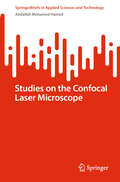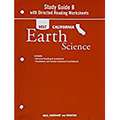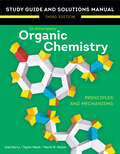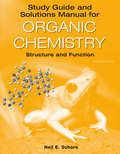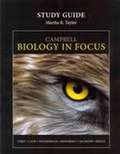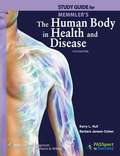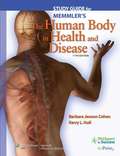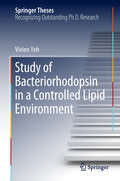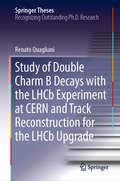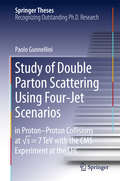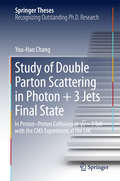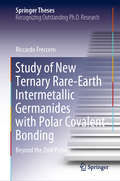- Table View
- List View
Studies on the Confocal Laser Microscope (SpringerBriefs in Applied Sciences and Technology)
by Abdallah Mohamed HamedThis book provides a thorough exploration of various modulated apertures and their impact on improving microscope resolution, with a focus on confocal scanning laser microscopy (CSLM). Over the course of eleven chapters, it looks at both the theoretical aspects and practical applications of different aperture shapes. Chapters 1 and 2 review apertures with linear, quadratic, and concentric black-and-white (B/W) zones, along with linear-quadratic and polynomial designs. Additionally, apertures with Hamming, Cauchy, rectangular, and hexagonal shapes are analyzed for their potential to enhance imaging performance. Chapter 3 presents the computation of coherent transfer functions (CTFs) for selected modulated apertures, offering insights into their influence on imaging quality. Chapter 4 focuses on confocal microscopes, exploring how these apertures affect the imaging of microscopic objects. A theoretical study of coherent non-scanned laser microscopes (CNSM) is covered in Chapter 5. Chapter 6 addresses the computation of lateral and axial point spread functions (PSFs) in confocal imaging systems that use binary amplitude masks, while Chapter 7 investigates the effects of misalignment errors combined with wavefront aberrations in systems using linear and quadratic apertures. In Chapter 8, diffraction intensity is calculated for a confocal microscope with a laterally displaced truncated Gaussian aperture, extending the principles of Marechal microscopy to confocal scanning microscopy. Chapters 9 and 10 examine spatial coherence in confocal optical systems, particularly in the context of quadratic and concentric B/W apertures. The book concludes in Chapter 11 with an application of cardiac apertures in CSLM, demonstrating their use in processing cardiac images. This work serves as a valuable reference for researchers and professionals interested in advancing microscope resolution through innovative aperture design and analysis.
Studies to Combat COVID-19 using Science and Engineering
by Hideyuki Kanematsu Dana BarryThis unique book provides excellent examples of ongoing, leading-edge research related to viruses, especially COVID-19. It is written from the viewpoint of various scientific fields including materials science. It introduces and describes viruses (submicroscopic infectious agents that replicate inside the living cells of an organism), various infections caused by viruses (human to human, human to other organisms to humans, humans to materials to humans, etc.), not only from the viewpoint of medical research but also from other scientific disciplines. A major focus of the book is the COVID-19 virus. Highlighted topics include the evolution of COVID-19, transmission of virus particles through the air, virus spread through various materials, detection of the virus by testing wastewater, the development and testing of vaccines and therapeutic drugs, and the preparation for future viruses and pandemics. This includes reform in funeral services to properly and safely accommodate very large numbers of bodies in a pandemic, like those seen in New York City when it was the epicenter for the virus in the United States. This book serves as an excellent and very informative guide (practical book) for engineers and researchers of various backgrounds and as a great academic textbook.
Study Guide B with Directed Readings Worksheets for Holt California Earth Science
by Holt Rinehart WinstonStudy Guide B with Directed Reading Worksheets will guide you through each section and focus your attention on key elements in the text. Vocabulary and Section Summary B Worksheets help you review Vocabulary Words and provide you with a bulleted list of the main topics from each Section.
Study Guide For The Human Body In Health And Illness
by Barbara HerlihyLearn the A&P you’ll really use in practice! The Human Body in Health and Illness, 6th Edition uses hundreds of illustrations, colorful cartoons, and an easy-to-read approach to simplify Anatomy & Physiology concepts. Organized by body system, this resource shows how each organ is designed to work by including clear, step-by-step explanations, clinical examples, and online animations. It also demonstrates what happens to the body when a system does not function properly. Written by well-known author and educator Barbara Herlihy, this resource makes it easier and more fun to learn A&P concepts — and gives you the basic background you need to begin a healthcare career.
Study Guide and Solutions Manual for Organic Chemistry (Third Edition)
by Joel Karty Taylor Mach Marie MelzerThe Study Guide and Solutions Manual provides students with fully worked solutions to all problems in the text. Each problem is stepped out using Joel Karty’s “Think and Solve” steps, and the guide includes solutions to all in-chapter Your Turn and Try It exercises, as well as all end-of-chapter problems. The Study Guide and Solutions Manual is available exclusively in ebook format. Access it here: https://digital.wwnorton.com/karty3ssm The Study Guide and Solutions Manual (to accompany Joel Karty’s Organic Chemistry: Principles and Mechanisms) provides immediate feedback for students working problems from the text. Solutions to all Your Turn, Try It, and end-of-chapter problems are stepped out in Joel’s “Think-Solve” steps.
Study Guide and Solutions Manual for Organic Chemistry: Structure And Function
by Neil SchoreThis manual includes chapter introductions that highlight new materials, chapter outlines, detailed comments for each chapter section, a glossary, and solutions to the problems, presented in a way that shows students how to reason their way to the answer.
Study Guide for Campbell Biology
by Jane B. Reece Martha R. Taylor Robert B. Jackson Michael L. Cain Peter V. Minorsky Lisa A. Urry Steven A. WassermanThis guide is designed for students to structure and organize their developing knowledge of biology and create their own personal understanding of the topics covered in the text, hence helping to streamline learning processes.
Study Guide for Campbell Biology in Focus
by Jane B. Reece Martha R. Taylor Robert B. Jackson Michael L. Cain Peter V. Minorsky Lisa A. Urry Steven A. WassermanThis study guide helps students extract key ideas from the textbook and organize their knowledge of biology. Exercises include concept maps, chapter summaries, word roots, chapter tests, and a variety of interactive questions in various formats.
Study Guide for Chemistry: A Molecular Approach
by Nivaldo J. Tro Jennifer ShanoskiThis Study Guide was written specifically to assist students using the third edition of Chemistry: A Molecular Approach . It presents the major concepts, theories, and applications discussed in the text in a comprehensive and accessible manner for students. It contains learning objectives, chapter summaries and outlines, as well as examples, self tests and concept questions.
Study Guide for Gould's Pathophysiology for the Health Professions (Fifth Edition)
by Karin C. Vanmeter Robert J. HubertThe book is on the background and overview of Pathophysiology,and related topics like defence and protective mechanisms,factors contributing to Pathophysiology etc.
Study Guide for Memmler's The Human Body in Health and Disease
by Barbara Janson Cohen Kerry L. HullThe Study Guide for Memmler's The Human Body in Health and Disease, 12th edition, helps students learn foundational concepts in anatomy and physiology required for success in allied health occupations. It will be more effective when used in conjunction with the 12th edition of Memmler's The Human Body in Health and Disease. The Study Guide may also be used to supplement other textbooks on basic anatomy and physiology.
Study Guide for Memmler's The Human Body in Health and Disease (11th Edition)
by Barbara Janson Cohen Kerry L. HullDesigned to accompany Memmler's The Human Body in Health and Disease, Eleventh Edition, this Study Guide provides students with additional self-study aids to help reinforce the material in the text. These self-study aids include chapter overviews, writing exercises, color atlas and labeling exercises, concept maps, practical applications, matching exercises and other question formats such as multiple choice, completion, true-false, and short essays.
Study Guide to Accompany Bob Garrett’s Brain & Behavior: An Introduction to Biological Psychology
by Bob GarrettRevised by Gerald Hough to accompany the Fourth Edition of Bob Garrett’s best seller, Brain & Behavior: An Introduction to Biological Psychology, the fully updated Student Study Guide provides additional opportunities for student practice and self-testing. Featuring helpful practice exercises, short answer/essay questions, as well as post-test multiple choice questions, the guide helps students gain a complete understanding of the material presented in the main text. Save your students money! Bundle the guide with the main text. Use Bundle ISBN: 978-1-4833-1832-5. The main text, Brain & Behavior: An Introduction to Biological Psychology, Fourth Edition, showcases our rapidly increasing understanding of the biological foundations of behavior, engaging students immediately with easily accessible content. Bob Garrett uses colorful illustrations and thought-provoking facts while maintaining a “big-picture” approach that students will appreciate. Don’t be surprised when they reach their “eureka” moment and exclaim, “Now I understand what was going on with Uncle Edgar!”
Study Guide to Accompany Garrett & Hough's Brain & Behavior: An Introduction to Behavioral Neuroscience
by Bob Garrett Gerald HoughCompletely revised to accompany the best-selling Brain & Behavior: An Introduction to Behavioral Neuroscience, Fifth Edition, the Study Guide offers students even more opportunities to review, practice, and master course material. Featuring chapter outlines, learning objectives, summaries and guided reviews, short answer and essay questions, multiple choice post-test questions, and answer keys, the guide reflects important updates made to the content in the main text to enhance student understanding.
Study Guide to Accompany Garrett & Hough's Brain & Behavior: An Introduction to Behavioral Neuroscience
by Bob Garrett Gerald HoughCompletely revised to accompany the best-selling Brain & Behavior: An Introduction to Behavioral Neuroscience, Fifth Edition, the Study Guide offers students even more opportunities to review, practice, and master course material. Featuring chapter outlines, learning objectives, summaries and guided reviews, short answer and essay questions, multiple choice post-test questions, and answer keys, the guide reflects important updates made to the content in the main text to enhance student understanding.
Study Skills for Geography, Earth and Environmental Science Students
by Pauline E. KnealeThis guide will help you to survive and thrive during your degree and on into the workplace. Everything you do at university can be useful in your career. Packed with practical hints, study tips, short cuts, real-life examples and careers advice, the new expanded fourth edition of this book is an invaluable resource throughout your geography, earth science or environmental science studies. This book provides guidance for successful study on many topics including: Starting as a student Being an effective researcher Presenting information effectively in posters, presentations, essays and reports Time management, well-being and ethics Field and laboratory work Assessment and feedback Written in an accessible style, this guide also explains the role of the academic, and how it differs from that of a school teacher. It prepares you for the world of work by showing how the skills you learn at university today can be used in your career choice of tomorrow.
Study Toxicology Through Questions
by John TimbrellA compilation of questions with answers for students of toxicology. The questions are a mixture of short answer, problem-solving, data interpretation and multiple choice and cover all the major areas of toxicology.
Study of Bacteriorhodopsin in a Controlled Lipid Environment (Springer Theses)
by Vivien YehThis book focuses on the study of how the properties of nanodiscs, such as lipid composition and size, influence the function of the embedding integral membrane protein, bacteriorhodopsin. The author performed systematic studies to show that the lipid composition and the charge of the hydrophobic head and the structure of hydrophilic tails affect the photocycle pathway of bacteriorhodopsin, which is closely associated with its proton-pumping activity. Furthermore, the author demonstrated a highly efficient method for extracting membrane proteins directly from the biological membrane, preserving protein conformation, function and essential native lipids. This book demonstrates optimization and sample preparation, and presents practical methods of preparing membrane protein-embedded nanodisc samples for biophysical studies, which benefit structural and functional studies in the field of membrane protein characterization, both.
Study of Double Charm B Decays with the LHCb Experiment at CERN and Track Reconstruction for the LHCb Upgrade
by Renato QuaglianiThis book discusses the study of double charm B decays and the first observation of B0->D0D0Kst0 decay using Run I data from the LHCb experiment. It also describes in detail the upgrade for the Run III of the LHCb tracking system and the trigger and tracking strategy for the LHCb upgrade, as well as the development and performance studies of a novel standalone tracking algorithm for the scintillating fibre tracker that will be used for the LHCb upgrade. This algorithm alone allows the LHCb upgrade physics program to achieve incredibly high sensitivity to decays containing long-lived particles as final states as well as to boost the physics capabilities for the reconstruction of low momentum particles.
Study of Double Parton Scattering Using Four-Jet Scenarios
by Paolo GunnelliniThis thesis addresses in a very new and elegant way several measurements and the extraction of so-called double parton scattering. The new and elegant way lies in the combination of measurements and a very smart extraction of double parton scattering results, which is easy to apply and overcomes many of the technical difficulties of older methods. Many new phenomena in particle physics can be observed when particles are collided at the highest energies; one of the highlights in recent years was the discovery of the Higgs boson at the Large Hadron Collider at CERN. Understanding the production mechanism of the Higgs boson at the LHC requires detailed knowledge of the physics of proton-proton collisions. When the density of partons in the protons becomes large, there is a non-negligible probability that more than one parton participates in the interaction and the so-called double parton scattering becomes important. In some cases very particular final state signatures can be observed, which can be regarded as an indication of such double partonic scattering and where the different interactions can be separated. Such multiple partonic interactions play an important role when precise predictions from known processes are required.
Study of Double Parton Scattering in Photon + 3 Jets Final State
by You-Hao ChangThis book mainly focuses on the study of photon + 3 jets final state in Proton-Proton Collisions at √s = 7TeV, searching for patterns of two (or more) distinct hard scatterings in the same collision, i. e the so-called Double Parton Scattering (DPS). A new method by using Monte Carlo generators was performed and provides higher order corrections to the description of the Single Parton Scattering (SPS) background. Further it is investigated whether additional contributions from DPS can improve the agreement between the measured data and the Monte Carlo predictions. The current theoretical uncertainties related to the SPS background are found to be larger than expectation. At the same time a rich set of DPS-sensitive measurements is reported for possible further interpretation.
Study of Ecological Engineering of Human Settlements
by Jianfeng ZhangThis book analyzes the theory of ecological engineering of human settlements and provides case studies on the improvement of degraded lands and vegetation restoration, especially focusing on saline-alkali land, abandoned land, water source areas, and the impact of green belts on noise and air quality on the highways. In addition, it discusses the issue of biodiversity conservation strategies in rural landscape construction and demonstrates experiment measurement and field survey methods. The results obtained are supplemented by numerical calculations, presented in the form of tables and figures.As the first monograph on this subject, the book provides a wealth of ideas and resources for researchers, professionals and practitioners in the field of human settlements.
Study of Excess Electronic Recoil Events in XENON1T (Springer Theses)
by Evan ShockleyThis thesis summarizes the original analysis work performed by the author on data from XENON1T, a search for dark matter with a ton-size noble liquid detector operated at Gran Sasso Underground Laboratory in Italy. The nature of dark matter is one of the most open and pressing questions of modern physics, and the unique data acquired with this detector allows the exploration and investigation of several potential scenarios. The analysis of Dr. Shockley searches for a class of elusive elementary particles that interact with the electrons of ordinary atoms, instead of the nucleus. Results of the analysis present, with high confidence, an excess with respect to the expected background. Beyond more mundane explanations, this additional rate of electron-mediated interactions might be a first hint of physics beyond the standard model. This accessible thesis provides details on the detector, the data, and the theory, delivering to the reader an in-depth and coherent picture of the search for physics beyond the standard model.
Study of Movement Speeds Down Stairs
by James A. Milke Bryan L. HoskinsThe Study of Movement Speeds Down Stairs closely examines forty-three unique case studies on movement patterns down stairwells. These studies include observations made during evacuation drills, others made during normal usage, interviews with people after fire evacuations, recommendations made from compiled studies, and detailed results from laboratory studies. The methodology used in each study for calculating density and movement speed, when known, are also presented, and this book identifies an additional seventeen variables linked to altering movement speeds. The Study of Movement Speeds Down Stairs is intended for researchers as a reference guide for evaluating pedestrian evacuation dynamics down stairwells. Practitioners working in a related field may also find this book invaluable.
Study of New Ternary Rare-Earth Intermetallic Germanides with Polar Covalent Bonding: Beyond the Zintl Picture (Springer Theses)
by Riccardo FrecceroThe thesis focuses on the syntheses, structural characterizations and chemical bonding analyses for several ternary R–M–Ge (R = rare earth metal; M = another metal) intermetallics. The challenges in understanding the main interactions governing the chemistry of these compounds, which lead to our inability to predict their formation, structure and properties, are what provided the motivation for this study. In particular, the R2MGe6 (M = Li, Mg, Al, Cu, Zn, Pd, Ag), R4MGe10-x (M = Li, Mg), R2Pd3Ge5, Lu5Pd4Ge8, Lu3Pd4Ge4 and Yb2PdGe3 phases were synthesized and structurally characterized. Much effort was put into the stabilization of metastable phases, employing the innovative metal flux method, and into the accurate structure solution of twinned crystals. Cutting-edge position-space chemical bonding techniques were combined with new methodologies conceived to correctly describe the Ge–M, Ge–La and also La–M polar-covalent interactions for the La2MGe6 (M = Li, Mg, Al, Cu, Zn, Pd, Ag) series. The present results constitute a step forward in our comprehension of ternary germanide chemistry as well as providing a good playground for further investigations.
